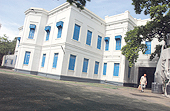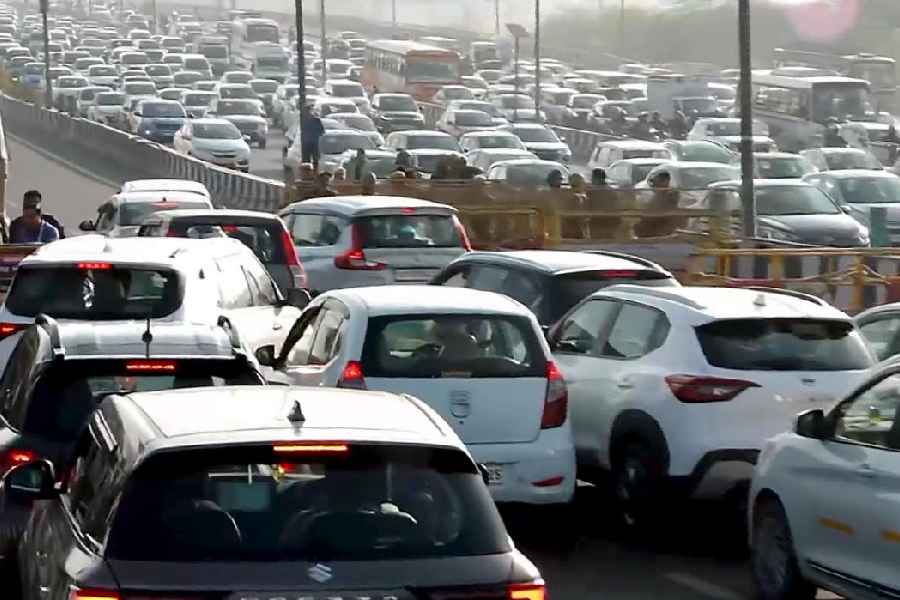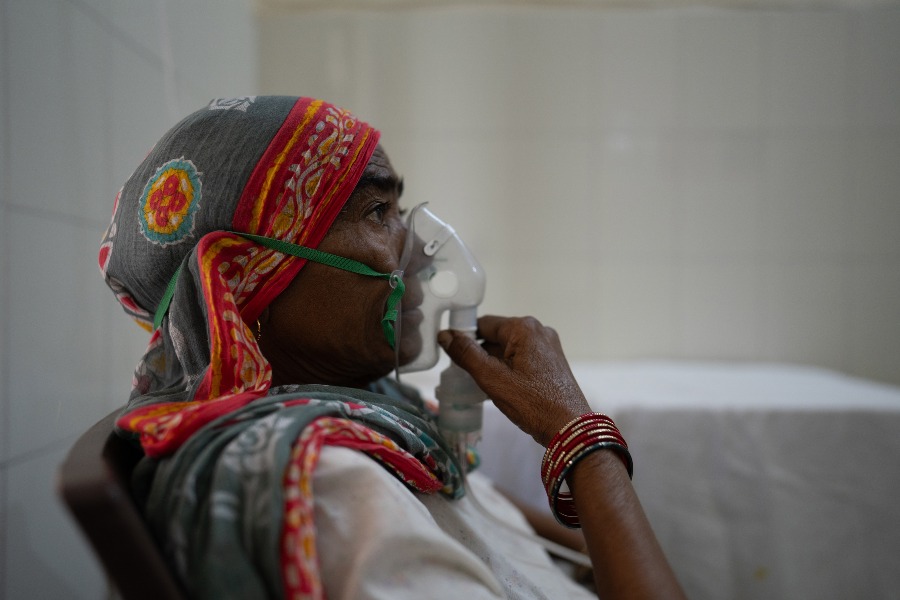 |
| A Freemasons Trust property on Park Street. Picture by Pabitra Das |
The cluster of fine buildings belonging to the Bengal Freemasons Trust Association at 19 Park Street is veiled in secrecy for more reasons than one. Being at the end of a twisting drive, the buildings are not visible from the street itself.
King Solomon had built the temple of god in Jerusalem with certain architectural features such as pillars with lily-shaped capitals. Although the freemasons of today have little to do with either Solomon or his temple, freemasonry is linked with the foundation of the fraternity of builders of this temple.
Symbolic use is made of the pillars in the architecture of buildings used by freemasons, as in the Park Street buildings, and also in the furniture and other paraphernalia used by this supposedly secret society in its esoteric rituals. It would not be an exaggeration to say that the halls with their banners and plentitude of wood resemble synagogues, harking back to King Solomon. The halls remain deserted at all hours of the day.
Apart from allegories and myths there is little historical evidence of how freemasonry originated. Besides the medieval guilds of stonemasons (letters are still addressed to the “English Craft Masons of Bengal”), according to popular belief, the society descended from Euclid or Pythagoras and even Moses, the Druids and the Gypsies and the descendants of Noah. One thing is clear, it is the exclusive knowledge of their craft that bound the early masons together. Hence the air of secrecy. All that the freemasons wanted to do was to promote the brotherhood of man.
 |
In England, the society was founded 300 years ago. Four London lodges came together on June 24, 1717 (St John the Baptist’s day) at the Goose and Gridiron Ale House in St Paul’s churchyard and formed what they called The Grand Lodge of England. In India, the trust association was formed in 1729. Headquartered in this city, its job was to look after its extensive properties in Bengal, Bihar, Kulti and Kanpur. It has under it 40 masonic lodges with about 20 to 30 members in each.
Its Park Street property is 123 cottahs and landsharks have been eyeing it for some time. Wedged between Park Hotel and Karnani Mansion it is prime property and its current value in the market would run into several mindboggling crores. Of late, the buildings have been given a facelift and now they are a gleaming white.
The large halls and “temples” on the first floor, where the “secret” masonic rites are performed, and the library with its cabinets of esoteric literature have been refurbished of late. It can boast several ancient prints of the holy city of Jerusalem and one of the London’s original lodge which was destroyed in the great fire. On the groundfloor are the banquet halls where the members — 400 in all — get together for meals and celebrations after each meeting.
George Pomfret was authorised by the grand master, Lord Kinston, to introduce freemasonry into Bengal in Calcutta, and the next year, Captain Ralph Farwinter was appointed the first provincial grand master for East India in Bengal. The first lodge established in Bengal is mentioned as Lodge East India Arms set up in 1730. It met in the Old Court House in Dalhousie Square. Subsequently, meetings were held in Lal Bazar, the Town Hall, and 55 Bentinck Street, till it moved into its Park Street premises. The corner stone of the west wing of Freemasons Hall was laid in 1911.
In the beginning, membership to lodges was confined to Europeans, although Indians were later admitted as members of the Order. Notable among its Indian members were Vivekananda, Nawab of Bhopal, W.C. Bonnerjee, Moti Lal Nehru, C. Rajagopalachari apart from royalty, ICS officers, jurists, doctors and statesmen.
In 1903, W.R. Burkitt, the then chief justice of Calcutta High Court, acquired the property at what was then 54 Park Street from the enormously rich, J.C. Galstaun, for Rs 145,000. It was bought in the name of Francis Granville Clarke, treasurer. Within a short period, the Bengal Freemasons Trust Association was formed, and all the property in Bengal, Kanpur, Bihar and Kulti was vested in its headquarters in Calcutta.
There was no attempt to tamper with the property till 1981, when the district grand master, Aramice Machkertich Adams, of Adams garage fame, leased out the plot to Modi Lakhotia Construction Company formed in October 24, 1981, for 99 years with Rs 21,000 in advance for the Lodge. It is said that before the deed could be registered Adams emigrated to Australia. What he did was illegal as the Freemasons Trust Association is a Section 25 company and no property it possesses can either be sold or purchased without a unanimous decision. Moreover, during Jyoti Basu’s tenure as chief minister, the buildings had been declared as heritage structures.
A see-saw battle continued till 1996 between those who supported the deal and those who were against it. The then grand master, L.O.H. d’Silva, instituted an inquiry with the assistance of those who were against the deal with Modi Lakhotia Construction Company. It was then that the United Grand Lodge of England intervened in 1996, and found that the deed was malafide. Satish Lakhotia, who was the treasurer of the freemasons trust association, was removed from that position.
The District Grand Lodge of Bengal was in the red at that time and could not pay the staff, the Calcutta Municipal Corporation dues and electricity bills. This was when Iqbal Ahmed, who had been a mason since 1965 and was initiated as district grand master in October 1998, stepped in and brought the situation under control. The malafide deed was terminated and the initial advance money was refunded. The brethren of the district grand lodge with assistance from the United Grand lodge of India paid up the dues and amended the Articles of Association of Bengal Freemasons Trust Association to ensure no such malafide deed can be carried out in future.
Nothing has been heard from Modi Lakhotia Construction Company since then, but to be doubly sure the trust association will file a petition asking the case to be closed. Unfortunately, despite the heritage status of the building it has not been given any tax rebate by the Bengal government, although the former mayor Subrata Mukherjee, during a visit to the Freemasons hall, had promised to exempt the trust association from taxes.











